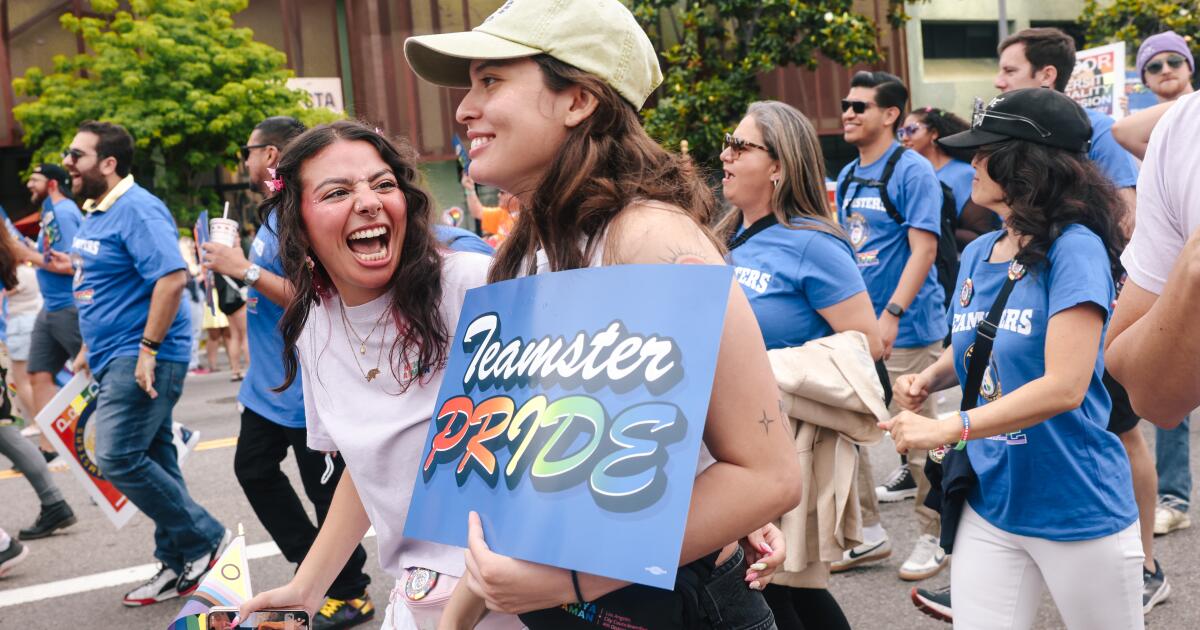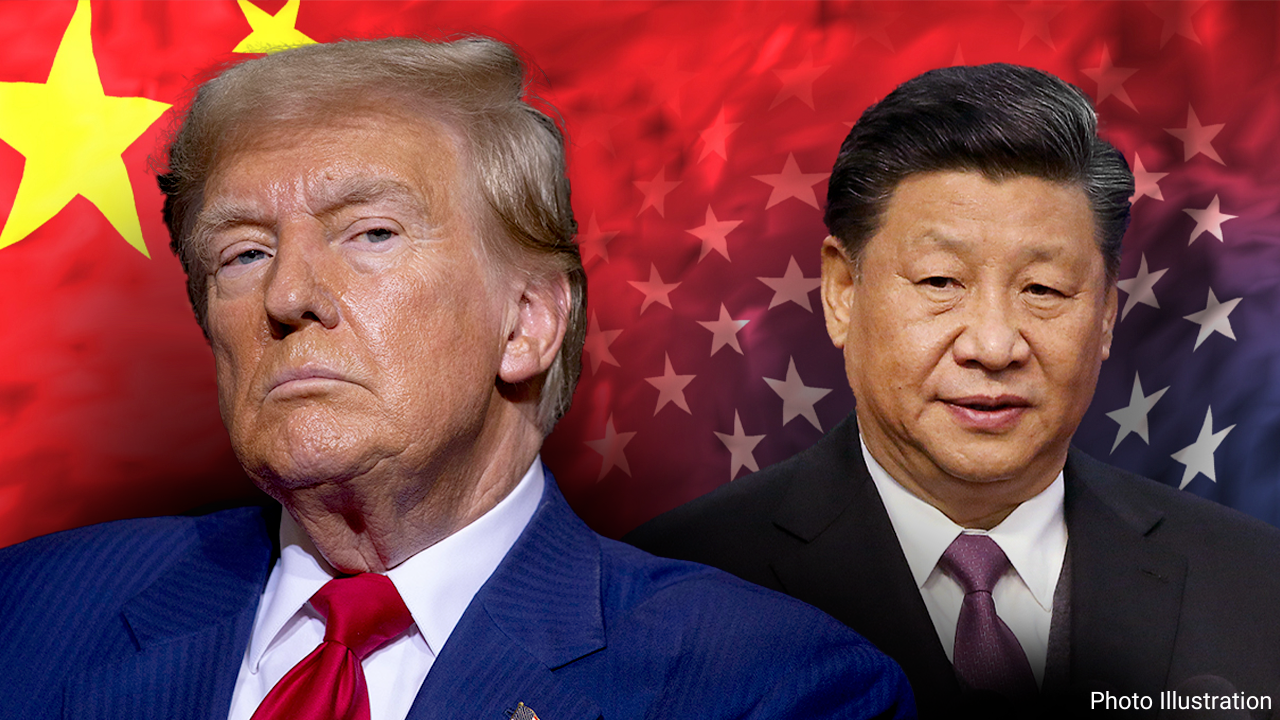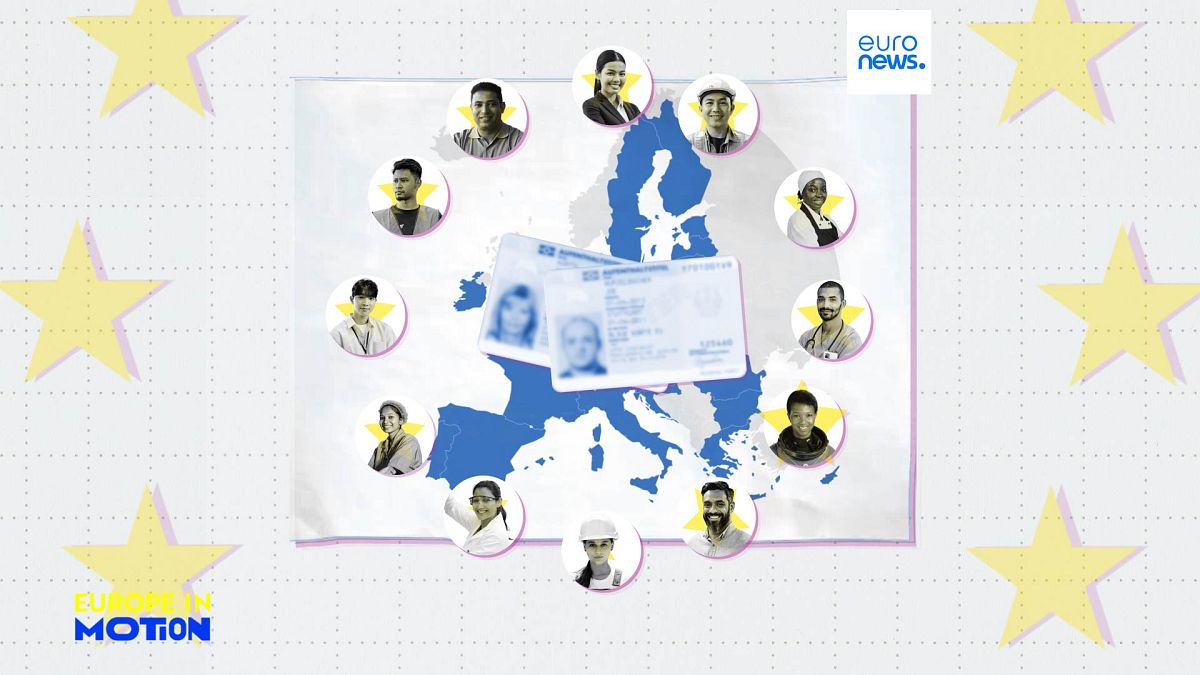Business
Hollywood Teamsters and other crew unions reach tentative deals with studios

A coalition of unions representing drivers, mechanics, location managers, electricians and other Hollywood crew members has struck tentative contract deals with the major studios — closing out a long, turbulent chapter of labor activity in the film and TV industry.
As of late Saturday night, the Hollywood Basic Crafts and the Alliance of Motion Picture and Television Producers have reached agreements on six different contracts. The settlements concluded several weeks of negotiations that became notably tense following a less contentious contract campaign led by fellow crew members union IATSE.
“After a long last 48 hours, we are proud to report that ALL Hollywood Basic Crafts Locals have reached a tentative agreement with the AMPTP late this evening,” Hollywood Basic Crafts spokesperson Amy Gorton said in a statement.
“The basic crafts spent today working closely with our member-led negotiating committees to finalize a deal with the AMPTP that we can now say is being unanimously recommended by our member-led bargaining committees.”
The six new contracts bargained by the Hollywood Basic Crafts include the Teamsters Local 399 Black Book Agreement covering drivers, dispatchers, transportation administrators, animal trainers, wranglers and mechanics; the Teamsters Local 399 Location Manager Agreement covering location managers, assistant location managers and key assistant location managers; the LiUNA! Local 724 Basic Agreement covering laborers; IBEW Local 40 Basic Agreement covering electricians; the OPCMIA Local 755 Basic Agreement covering plasterers; and the UA Local 78 Basic Agreement covering plumbers.
They include terms related to pay, pension and health benefits, streaming residuals, artificial intelligence and autonomous vehicles.
The old agreements — covering a total of roughly 7,600 below-the-line workers — were set to expire July 31.
While bargaining with the AMPTP over the past several weeks, Hollywood Basic Crafts leaders repeatedly called out the entertainment companies for allegedly dragging their feet at the bargaining table and failing to adequately address key issues affecting crew members.
The heated tone of the negotiations was a marked shift from IATSE’s contract campaign, which transpired largely without incident and culminated in a deal covering some 50,000 craftspeople primarily based in Los Angeles. IATSE members ratified the new Hollywood Basic Agreement earlier this month.
The final week of the Hollywood Basic Crafts campaign saw several other entertainment unions — including IATSE, the American Federation of Musicians, the Writers Guild of America, the Directors Guild of America and the Screen Actors Guild — issue a joint statement pressuring the AMPTP “to respect their workforce and make meaningful moves at the negotiating table.”
“As their contract deadline of July 31st quickly approaches, the clock is ticking on the AMPTP to address the unique needs of the various classifications within these unions,” the statement read.
“Our guilds and unions stand strongly united behind the Teamsters and Hollywood Basic Crafts until they gain the compensation and working conditions they deserve.”
On Friday, the AMPTP came to the bargaining table with what it deemed its “last, best and final” offer, the union said. The Hollywood Basic Crafts said it rejected that proposal and presented the studios with a counteroffer it felt strongly about.
“These aren’t just proposals on a piece of paper to our members. These are meaningful terms and conditions that impact their livelihoods,” Lindsay Dougherty, principal officer of Teamsters Local 399 and chairperson of the Hollywood Basic Crafts, said Saturday in a statement.
“We think our response to the producer’s package is reasonable and would be a deal that gets this over the finish line.”
Throughout negotiations, Hollywood Basic Crafts leaders maintained that they were not looking to call a strike but cautioned that they were not interested in extending talks past the contracts’ expiration date.
Fears of a potential crew member walkout peaked in the immediate aftermath of the writers’ and actors’ strikes, which rendered thousands of entertainment workers jobless for about six months. Even since the work stoppages lifted, many remain unemployed due to an ongoing industry contraction that predates the labor disputes.
Concerns of a third strike began to dissipate, though, once the IATSE contracts started falling into place.

Business
CalRecycle drafts revised plastic recycling rules that are more friendly to industry

State waste officials have taken another stab at rules implementing a landmark plastic waste law, more than two months after Gov. Gavin Newsom torpedoed their initial proposal.
CalRecycle, the state agency that oversees waste management, recently proposed a new set of draft regulations to implement SB 54, the 2022 law designed to reduce California’s single-use plastic waste. The law was designed to shift the financial onus of waste reduction from the state’s people, towns and cities to the companies and corporations that make the polluting products. It was also intended to reduce the amount of single-use plastics that end up in California’s waste stream.
The draft regulations proposed last week largely mirror the ones introduced earlier this year, which set the rules, guidelines and parameters of the program — but with some minor and major tweaks.
The new ones clarify producer obligations and reporting timelines, said organizations representing packaging and plastics companies, such as the Circular Action Alliance and the California Chamber of Commerce.
But they also include a broad set of exemptions for a wide variety of single-use plastics — including any product that the U.S. Food and Drug Administration and the U.S. Department of Agriculture have jurisdiction over, which includes all packaging related to produce, meat, dairy products, dog food, toothpaste, condoms, shampoo and cereal boxes, among other products.
The rules also leave open the possibility of using chemical or alternative recycling as a method for dealing with plastics that can’t be recycled via mechanical means, said people representing environmental, recycling and waste hauling companies and organizations.
California’s attorney general, Rob Bonta, filed a suit against ExxonMobil last year that, in part, accuses the oil giant of deceptive claims regarding chemical recycling, which the company disputes.
Critics say the introduction of these exemptions and the opening for polluting recycling technologies will undermine and kneecap a law that just three years ago Newsom’s office described as “nation-leading” and “the most significant overhaul of the state’s plastic and packaging policy in history.”
The “gaping hole that the new exemptions have blown” into the bill make it unworkable, practically unfundable, and antithetical to its original purpose of reducing plastic waste, said Heidi Sanborn, director of the National Stewardship Action Council.
Last March, after nearly three years of negotiations among various corporate, environmental, waste, recycling and health stakeholders, CalRecycle drafted a set of finalized regulations designed to implement the single-use plastic producer responsibility program under SB 54.
But as the deadline for implementation approached, industries that would be affected by the regulations including plastic producers and packaging companies — represented by the California Chamber of Commerce and the Circular Action Alliance — began lobbying the governor, complaining the regulations were poorly developed and might ultimately increase costs for California taxpayers.
Newsom allowed the regulations to expire and told CalRecycle it needed to start the process over.
Daniel Villaseñor, a spokesman for the governor, said Newsom was concerned about the program’s potential costs for small businesses and families, which a state analysis estimated could run an extra $300 per year per household.
He said the new draft regulations “are a step in the right direction” and they ensure “California’s bold recycling law can achieve its goal of cutting plastic pollution,” said Villaseñor in a statement.
John Myers, a spokesman for the California Chamber of Commerce, whose members include the American Chemistry Council, Western Plastics Assn. and the Flexible Packaging Assn., said the chamber was still reviewing the changes.
CalRecycle is holding a workshop next Tuesday to discuss the draft regulations. Once CalRecycle decides to finalize the regulations, which experts say could happen at any time, it moves into a 45-day official rule-making period during which the regulations are reviewed by the Office of Administrative Law. If it’s considered legally sound and the governor is happy, it becomes official.
The law, which was authored by state Sen. Ben Allen (D-Santa Monica) and signed by Newsom in 2022, requires that by 2032, 100% of single-use packaging and plastic foodware produced or sold in the state must be recyclable or compostable, that 65% of it can be recycled, and that the total volume is reduced by 25%.
The law was written to address the mounting issue of plastic pollution in the environment and the growing number of studies showing the ubiquity of microplastic pollution in the human body — such as in the brain, blood, heart tissue, testicles, lungs and various other organs.
According to one state analysis, 2.9 million tons of single-use plastic and 171.4 billion single-use plastic components were sold, offered for sale or distributed during 2023 in California.
Most of these single-use plastic packaging products cannot be recycled, and as they break down in the environment — never fully decomposing — they contribute to the growing burden of microplastics in the air we breathe, the water we drink, and the soil that nourishes our crops.
The law falls into a category of extended producer responsibility laws that now regulate the handling of paint, carpeting, batteries and textiles in California — requiring producers to see their products throughout their entire life cycle, taking financial responsibility for their products’ end of life.
Theoretically such programs, which have been adopted in other states, including Washington, Oregon and Colorado, spur technological innovation and potentially create circular economies — where products are designed to be reused, recycled or composted.
Sanborn said the new exemptions not only potentially turn the law “into a joke,” but will also dry up the program’s funding and instead put the financial burden on the consumer and the few packaging and single-use plastic manufacturers that aren’t included in the exemptions.
“If you want to bring the cost down, you’ve got to have a fair and level playing field where all the businesses are paying in and running the program. The more exemptions you give, the less funding there is, and the less fair it is,” she said.
In addition, because of the way residential and commercial packaging waste is collected, “it’s all going to get thrown away together, so now you have less funding” to deal with the same amount of waste, but for which only a small number of companies will be accountable for sorting out their material and making sure it gets disposed of properly.
Others were equally miffed, including Allen, the bill’s author, who said in a statement that while there are some improvements in the new regulations, there are “several provisions that appear to conflict with law,” including the widespread exemptions and the allowance of polluting recycling technologies.
“If the purpose of the law is to reduce single-use plastic and plastic pollution,” said Anja Brandon from the Ocean Conservancy, these new regulations aren’t going to do it — they are “inconsistent with the law and fully undermine its purpose and goal.”
Nick Lapis with Californians Against Waste said his organization was “really disappointed to see the administration caving to industry on some core parts of this program,” and also noted his read suggests many of the changes don’t comply with the law.
Next Tuesday, the public will have an opportunity to express concerns at a rulemaking workshop in Sacramento.
However, Sanborn fears there will be little time or appetite from the agency or the governor’s office to make substantial changes to the new regulations.
“They’re basically already cooked,” said Sanborn, noting CalRecycle had already accepted public comments during previous rounds and iterations.
“California should be the leader at holding the bar up in this space,” she said. “I’m afraid this has dropped the bar very low.”
Business
OpenAI teams up with former Apple design chief Jony Ive as AI race heats up

Jony Ive, a former Apple executive known for designing the iPhone, is joining forces with OpenAI, the San Francisco startup behind popular chatbot ChatGPT.
On Wednesday, OpenAI said it’s buying io, an AI devices startup that Ive founded a year ago, for nearly $6.5 billion in an all-stock deal, the largest acquisition in OpenAI’s history.
“We have the opportunity here to kind of completely reimagine what it means to use a computer,” OpenAI Chief Executive Sam Altman said in a video with Ive about the partnership.
The pair don’t specify what AI devices they’re working on, but Altman called it “the coolest piece of technology that the world will have ever seen.”
The partnership shows how OpenAI is taking on some of the world’s most powerful tech companies including Google, Apple and Meta that are also working on AI-powered devices to shape the future of computing.
Chirag Dekate, a VP analyst at Gartner, said the announcement reflected an “inflection point” in the tech industry, where future products and services will offer users more personalized and proactive assistance.
“This shift suggests a future where technology is less about the tools themselves and more about the intelligently orchestrated experiences they enable,” he said in an email.
Globally, spending on generative AI is expected to total $644 billion in 2025, an increase of 76.4% from 2024, according to a forecast by Gartner, a research and advisory firm based in Connecticut that focuses on technology.
The race to build AI-powered wearable gadgets and roll out more AI tools that can generate video, text and code and help people shop also means that major tech companies are recruiting top-tier talent. Earlier in May, OpenAI hired Fidji Simo, a former top Meta executive and the chief executive of grocery delivery startup Instacart, to lead the startup’s applications team.
Ive, a British American designer, is a well-known figure in the tech industry because he designed some of Apple’s iconic products such as the Macbook, iPhone, iPad and iPod. Joining Apple in the 1990s, Ive became Apple’s chief design officer in 2015.
He left the company in 2019 and started LoveFrom, a creative collective and design firm that worked with brands including OpenAI.
Silicon Valley tech companies have been working on gadgets, including headsets and glasses, for years but they’re still not as ubiquitous as the smartphone.
There have also been major flops such as Humane’s AI pin, a wearable virtual voice-operated assistant that was criticized for various issues such as providing inaccurate information and overheating. In February, San Francisco-based Humane shut down the AI pin after it was acquired by Hewlett-Packard.
But the fumbles haven’t stopped tech companies from barreling forward with building glasses, brain-computer interfaces and humanoid robots as they look to a future beyond the smartphone.
When Google released smart glasses in 2013 that could shoot photos and videos, the company faced concerns about people using the device to surreptitiously record other people or read text while ignoring others.
But the gadget resurfaced years later. This week, Google unveiled a prototype of its AI smart glasses at its annual I/O developer conference in Mountain View, demonstrating how people can use the device to search for information about a painting, travel and other topics without having to type on their smartphone. The search giant is partnering with eyewear brands Warby Parker and Gentle Monster on smart glasses.
Last year, Santa Monica-based Snap unveiled the fifth generation of Spectacles, its augmented reality glasses that overlay digital objects on the physical world. The device, which was only available for developers, allowed people to play with virtual pets, conjure up images with a voice command or swing a virtual golf club.
Meta teamed up with Ray-Ban on smart glasses that include an AI assistant that can answer questions, translate and help take a photo. It’s also working on a more powerful pair of AR glasses that lets people take video calls, get recipe recommendations and multitask in other ways.
And Apple, which unveiled a pricey mixed-reality headset known as the Vision Pro in 2023, is also reportedly working on smart glasses.
In the video with Altman, Ive said the products that people use to connect to technology are decades old, so it’s “just common sense to at least think surely there’s something beyond these legacy products.”
“I have a growing sense that everything I’ve learned over the last 30 years has led me to this place and to this moment,” Ive said in the video.
Business
Darren Aronofsky joins AI Hollywood push with Google deal

Director Darren Aronofsky has pushed artistic boundaries with movies including “Requiem for a Dream” and “Mother!”
Now his production company is working with Google to explore the edge of artificial intelligence technology in filmmaking.
Google on Tuesday said it is working with several filmmakers to use new AI tools as part of a larger push to popularize the fast-moving tech. That effort includes a partnership with Aronofsky’s venture, Primordial Soup.
Google’s AI-focused subsidiary DeepMind and Aronofsky’s firm will work with three filmmakers, giving them access to the Mountain View, Calif.-based giant’s text-to-video tool Veo, which they will use to make short films. The first project, “Ancestra,” is directed by Eliza McNitt. Aronofsky is an executive producer on the film. “Ancestra,” which premieres at the Tribeca Festival next month, combines live-action filmmaking with imagery generated with AI, such as cosmic events and microscopic worlds.
“Filmmaking has always been driven by technology,” Aronofsky said in a statement that referenced film tech pioneers the Lumiere brothers and Thomas Edison. “Today is no different. Now is the moment to explore these new tools and shape them for the future of storytelling.”
The push comes as Google and other companies are making deals with Hollywood talent and production companies to use their AI tools. For example, Facebook parent company Meta is partnering with “Titanic” director James Cameron’s venture, Lightstorm Vision, to co-produce content for its virtual reality headset Meta Quest. New York-based AI startup Runway has a deal with “Hunger Games” studio Lionsgate to create a new AI model to help with behind-the-scenes processes such as storyboarding.
Many people in Hollywood have been critical of AI tools, raising concerns about the automation of jobs. Writers worry about AI models being trained on their scripts without their permission or compensation. Tech industry executives have said that they should be able to train AI models with content available online under the “fair use” doctrine, which allows for the limited reproduction of material without permission from the copyright holder.
Proponents of the technology say that it can provide more opportunities for filmmakers to test out ideas and show a variety of visuals at a lower cost.
New York-based Primordial Soup said in a press release that Google’s AI tools helped solve “practical challenges such as filming with infants and visualizing the birth of the universe” in “Ancestra.”
“With ‘Ancestra,’ I was able to visualize the unseen, transforming family archives, emotions, and science into a cinematic experience that feels both intimate and expansive,” McNitt said in a statement.
The two additional filmmakers and films participating in the Google DeepMind-Primordial Soup deal are not yet named.
Google made the announcement as part of its annual I/O developer conference in Mountain View.
During the event’s keynote address on Tuesday, Google shared updates on its AI tools for filmmakers, including Veo 3, which allows creators to type in how they want dialogue to sound and add sound effects. The company also unveiled a new AI filmmaking tool called Flow that helps users create cinematic shots and stitch together scenes into longer films and short stories.
“This opens up a whole new world of possibilities,” said Demis Hassabis, chief executive of Google DeepMind, in a news briefing on Monday. “We’re excited for how our models are helping power new tools for creativity.”
Flow is available through Google’s new $249.99 monthly subscription plan Google AI Ultra, which includes early access to Veo 3, as well as other benefits including YouTube Premium, Google’s AI models Gemini and other tools. Flow is also available with a $19.99-a-month Google AI Pro subscription.
Google is making other investments related to AI. On Tuesday, L.A.-based generative AI studio Promise announced Google AI Futures Fund as one of its new strategic investors. Through the partnership, Promise will integrate some of Google’s AI technologies into its production pipeline and workflow software and collaborate with Google’s AI teams.
-

 Education1 week ago
Education1 week agoHarvard Letter Points to ‘Common Ground’ With Trump Administration
-

 Culture1 week ago
Culture1 week agoBook Review: ‘Original Sin,’ by Jake Tapper and Alex Thompson
-

 News1 week ago
News1 week agoAs Harvard Battles Trump, Its President Will Take a 25% Pay Cut
-

 News1 week ago
News1 week agoAustin Welcomed Elon Musk. Now It’s Weird (in a New Way).
-

 Culture1 week ago
Culture1 week agoBook Review: ‘Death Is Our Business,’ by John Lechner; ‘Putin’s Sledgehammer,’ by Candace Rondeaux
-

 Education1 week ago
Education1 week agoVideo: Opinion | We Study Fascism, and We’re Leaving the U.S.
-

 News1 week ago
News1 week agoMenendez Brothers Resentenced to Life With Parole, Paving Way for Freedom
-

 Politics1 week ago
Politics1 week agoRepublicans say they're 'out of the loop' on Trump's $400M Qatari plane deal
















